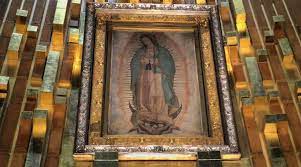In the realm of religious artifacts, few are as revered and mysterious as the tilma of Our Lady of Guadalupe. Housed in the Basilica of Our Lady of Guadalupe in Mexico City, this humble piece of cloth, imprinted with an image of the Virgin Mary, defies the laws of science and nature, leaving researchers and the faithful alike in awe. It is a miraculous enigma, challenging our understanding of preservation and offering a profound testament to the divine.
A Cloak Woven with Mysteries
The story of the Guadalupe tilma, or "tilma de Juan Diego," begins in December 1531. In 1531, the Virgin Mary appeared to Juan Diego, a Nahuatl peasant, on the hill of Tepeyac. She instructed him to gather roses, which should have been impossible to find in the barren landscape at that time of year. When Juan Diego presented the roses to the bishop, the Virgin's image miraculously appeared on his tilma, woven from the coarse fibers of the agave cactus.
The image on the tilma, known as the "Virgen de Guadalupe" or "Our Lady of Guadalupe," is a powerful symbol of Mexican identity and Catholic faith. But it's not just the image that captivates the world; it's the inexplicable preservation of the tilma itself.
The Science of Decay: A Natural Timeline
Ordinarily, a fabric made from agave fibers like Juan Diego's tilma should have disintegrated long ago. These fibers are known to break down in a matter of decades or, at most, a century. Yet, the Guadalupe tilma has defied the natural timeline of deterioration.
The first scientific examination of the tilma took place in 1789, more than two centuries after the miraculous imprint. Scientists and experts were astounded to find no evidence of the usual wear and tear on the fabric. Over the centuries, the tilma has been exposed to dust, pollution, candle soot, and physical contact by millions of pilgrims. It should have been severely damaged, if not destroyed.
Moreover, there is no sign of paint, pigments, or any other human-made substance that could explain the image on the tilma. This absence of conventional artistic materials deepens the mystery. The lack of an identifiable paint source contributes to the miraculous nature of the tilma.
The Perfect Preservation
In 1921, the Basilica of Our Lady of Guadalupe was bombed during the Mexican Revolution. The tilma should have been severely damaged or destroyed, but it remained unscathed. In 1979, a bomb exploded a few feet from the tilma, causing damage to the marble floor and the stained-glass windows, but once again, the tilma itself was unharmed.
The preservation of the tilma even extends to the image itself. Experts have been unable to determine how the image was created, but they are certain that it has not been retouched or altered. It has not faded, despite being exposed to the elements and the candle smoke of countless pilgrims for centuries.
The Sound of Mystery: The Mystery of the Fabric's Sound Emission
Adding to the perplexity, in the 1970s, a Mexican engineer named José Aste Tonsmann made an astonishing discovery. He was examining high-resolution photographs of the tilma when he noticed that the stars in the image were not randomly arranged; they formed the constellations as they would have appeared on December 12, 1531. Even more astonishing, when he measured the distance between the stars, he found that they corresponded exactly to the golden ratio, a mathematical proportion associated with divine beauty and aesthetics.
Tonsmann also discovered that the image emits mysterious sounds. When he examined the image with a Geiger counter, he found that it produced a unique, unexplained ultrasound, unlike any natural sound. This peculiar emission has puzzled scientists and researchers.
A Living Testament to the Divine
The inexplicable preservation of the Guadalupe tilma stands as a powerful testament to the divine. It is a relic that has transcended the boundaries of time and science. Believers and scientists continue to be astounded by its endurance, and countless pilgrims travel to Mexico City to witness this miraculous piece of cloth.
The Guadalupe tilma is a living mystery, a testament to faith, and a symbol of hope for believers around the world. It continues to capture hearts and minds, inspiring awe and wonder as it defies the natural order of decay. In a world where science and faith often seem at odds, the Guadalupe tilma bridges the gap, reminding us that sometimes, the most wondrous phenomena are those that elude explanation.

